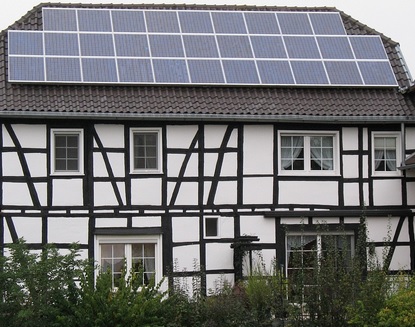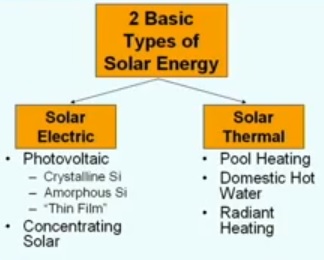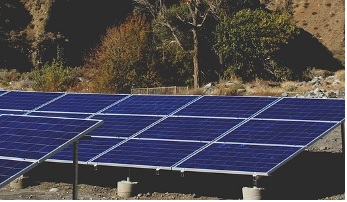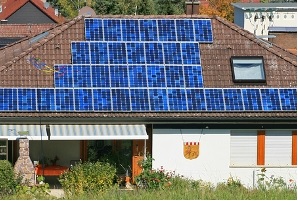
Here are useful ideas & tips on Solar Energy and Solar Panel Installation.
A solar system has to be set-up in a specific manner for it to work efficiently. Most designs that are available today are the result of hundreds and thousands of installations that have been refined over the years.
GET INSTANT HELP FROM EXPERTS!
- Looking for any kind of help on your academic work (essay, assignment, project)?
- Want us to review, proofread or tidy up your work?
- Want a helping hand so that you can focus on the more important tasks?
Hire us as project guide/assistant. Contact us for more information
When deciding on the placement of Solar panels for home use, it helps to know exactly what you need to get your solar energy system hooked up and running smoothly. There are websites that offer a type of calculator for figuring the number of batteries and solar panels you will need to run your household. Once the number of batteries and panels are decided upon, the proper wiring of the batteries and panels need to take place.

Solar Power Installation at Home Checklist
Once you have decided that you want to setup a solar power system at home, here’s how to go about it. Remember, you’ll need to give some thought to the locations and angle of the solar panels if you want the installation to be smooth.
Here’s how to install solar power the right way:
- Do a check to determine the amount of space you have on your roof to setup the panels. The inspection will give you an idea of the number of solar panels you can place, and also the power you can get.
- Get someone to assist you in the the installation process, as it involves working on the roof.
- Zero-in on locations that will provide maximum sunlight to the solar panels. See if there are trees blocking the path of the sun, or if there are shadows from adjacent buildings. You may have to cut a few tree branches to make sure the place receives maximum sunlight.
- Think where and how you’ll place the panels, based on that you’ll be able to determine the kind of mounts you’ll require. The popular mounting types include flush mounts, roof-ground mounts and pole mounts, and the common mounting materials include aluminium, angle iron, stainless steel and wood.
- Use a stud finder for locating the rafters on your house roof. This is an important step in the installation procedure because the rafters tend to support the solar panels after they are installed.
- You’ll need to make sure the mounts are correctly aligned; so locate the specific spots and use a lightweight cord or a string to ensure the correct alignment of the mounts.
- Pre-drill holes on the roof mounts to save your rafters from damage in the later steps of installation.
- Use lag bolts to secure the mounts in place. Attach the rails to the mounts with 3/8-inch bolts. Attach the solar panels to the mounts with roofing screws. Make sure each panel is secure in place.
- Run a conduit from the panels to the converter in your home. Make sure the conduit is well-secured and not vulnerable to weather changes.
Source: ehow.com
Ground Mounted Solar Panels
If you have lots of open space around and if roof top space is limited, installing Ground Mounted Solar Panels is one of the most cost effective ways to produce solar electricity.

These can usually be installed in under one week from start to finish.
Using Pole Mounts
Most of these mounts can be height-adjusted or tilted for more efficiency in capturing sunlight. Pole mounts are usually available as three subcategories: top, side and tracking pole.
Solar panels on top and side pole mounts are positioned permanently, either on the top or the side. Tracking pole mounts, however, have the ability to track the sun’s movement throughout the day (similar to a sunflower that always finds where the sun is) to take full advantage of the sunlight.
The type of mount that you’ll require depends on the size of your solar panels and also on the design of the open space available for setting up the panels.
Here’s a video that shows how to setup Ground Mounted Solar Panels:
GET INSTANT HELP FROM EXPERTS!
- Looking for any kind of help on your academic work (essay, assignment, project)?
- Want us to review, proofread or tidy up your work?
- Want a helping hand so that you can focus on the more important tasks?
Hire us as project guide/assistant. Contact us for more information
Roof Mounted Solar Panels
Here are instructions on how to Install Roof Mounted Solar Panels, and the best practices that you need to follow.

I’m sure you can do this by getting help from an expert, and by paying a bit more. However, if you wish to do it all by yourself here are some good instructional videos.
Here are some things to keep in mind:
- Preferably use Hotdip galvanized unistrut; they are costly but they are safe and long lasting
- Unistrut won’t corrode as the zinc coating thickness is more in hot deep galvanized steels.
- Avoid putting them directly on the roof surface as it increases the corrosion activity, because the roof surface is usually made of materials that enhances the corrosion activity, especially during the wet season.
- Try using hot dipped galvanized unistrut (with spacers) so that there’s a small gap between the strut and the roof.
- If you use other material (for instance zinc, instead of the hot dipped galvanized ones), make sure you paint them so that they don’t rust.
Here’s are a couple of videos that shows how to mount/install solar panels on the roof.
Solar Panel Installation For Sloped And Flat Roofs
The solar panel Installation can be carried out on different types of roofs, and the panels can be either flush mounted or tilted up. If it is possible, it would be best if you install the panel mounts when the home is getting re-roofed. When you “flash-in” the solar mounts at the time of roofing, it would eliminate any chances of a leak in the roof. Additionally, it makes it easy to find the rafters when there is no roof. The mounts have to be secured on the roof using stainless steel lag bolts and these bolts are bolted into the rafters.
The “flashing-in” of the structural attachment points is the ideal method for solar panel Installation. it would also help in eliminating the cost of removing and reinstalling for several decades. The easiest roofs to install solar panels are the composition shingles. Whereas, it is more difficult to work with tile roofs, especially when it comes to carrying the solar panels over them.
The process of installation given below describes how you can mount the photovoltaic panels on a sloped roof, followed by another demonstration of installation on a flat roof. It would also guide you about the incorporation of solar mounts on a new roof.
Sloped Roof Solar Panel Installation
Begin by choosing only professional solar products. The first step in solar panel Installation is to align the mounts on top of the rafters and then they are pre-drilled with pilot bits for avoiding any split in the rafters. You can find the rafters using the stud finder. Next, a laser sight or a chalk line is to be used for keeping all the mounts in a straight line. The mounts are then secured on the roof using stainless steel lag bolts.
The next step in the sloped-roof solar panel Installation process is to place metal flashings on the mounts. The roofing layer is then hot-mopped around these mounts. The metal rails are then secured with the posts using stainless steel bolts. The solar panels are then installed and connected together to create an array. The sloped-roof installation would end by running the conduit for connecting the panels with the inverter.
Flat Roof solar panel Installation
The following installation process would demonstrate how the solar panels are to be installed on a flat roof. Begin with professional solar panel products including the mounts. The mounts are first aligned on top of the rafters and rafters and pre-drilled using pilot bits. Use the stud finder for locating the rafters. Usually, they would be 16 inch or 24 inches apart, so that the mounts can be placed at every 48-inch distance. The mounts can be kept in a straight line using a chalk line.
Next, the mounts can be secured to the roof using stainless steel lag bolts, and the post is threaded into the base. Similarly keep installing all the required mounts and threading the posts. Take metal roof flashing of 3/4 inches and place them over the mounts. Once the new roof is applied, the metal channel is secured on top of the mounts. The aluminium solar panel racks are then assembled and secured onto this metal channel. Securing the solar panels would then complete the solar panel Installation process.
Considerations
- The solar products and the solar panel Installation process can cost you several thousand pounds. But, once you have installed the system, you can remain assured that you would have free power as long as the sun keeps shining.
- That is if the panels are maintained from time to time.
Before you purchase any type of solar power systems, make sure you consult professional and licensed installers. They would be able to guide you about the type of system that would work best in your location. - If you require solar power only for heating water for household purposes or swimming pool, you would need a simple solar panel Installation for the solar thermal system. It would usually have a solar collector, connected with the plumbing work of your home. And, these solar collectors are mostly mounted on the rooftops.
Source: solar-panel-installation.net
Using Standard Inverter with Solar Panels
A standard inverter tells the user when & how much power is coming in and how much is going out. Learn about standard inverters for solar power from a professional in this free energy conservation video.
Solar Panel Installers: Professional Help
Consumers usually avoid professional solar panel installers because it adds to the overall cost. For most home needs you can definitely do things on your own, however there are certain situations where it makes sense to take specialized help. Most solar panel shops nowadays assist you in installing the solar panels, as part of their after sales service. Besides, solar panel installers are good with their work, obviously because they’re skilled. Well, its not a must to hire an outside party to take care of the installation, but it helps to know that you’ve an option.
Here are some more reasons why you may want to take the help of professionals:
- Not everybody can get on to the roof, especially with all those panels and mounts and other materials. If you’re afraid of heights, leave this task to the solar panel installers.
- If you buy the solar panels from a shop, you can actually avail the services of their solar panel installers to do all the wiring & setup. This way you’re covered against any damages/problems with the panels.
- If you’re bad with electronic/electric devices or DIY stuff, or don’t have sufficient time to learn, seek the help of professional installers. You don’t want anyone to get electrocuted ow ant an electrical fire to break out (well, those are extreme scenarios but possible if you don’t have any clue about wiring).
- If you’re really short of time and/or cannot delay the installation because you want to avail of some tax saving incentive/subsidy, take professional help. The installation will be much faster and will look much cleaner.
GET INSTANT HELP FROM EXPERTS!
- Looking for any kind of help on your academic work (essay, assignment, project)?
- Want us to review, proofread or tidy up your work?
- Want a helping hand so that you can focus on the more important tasks?
StudyMumbai.com is an educational resource for students, parents, and teachers, with special focus on Mumbai. Our staff includes educators with several years of experience. Our mission is to simplify learning and to provide free education. Read more about us.

Leave a Reply
You must be logged in to post a comment.